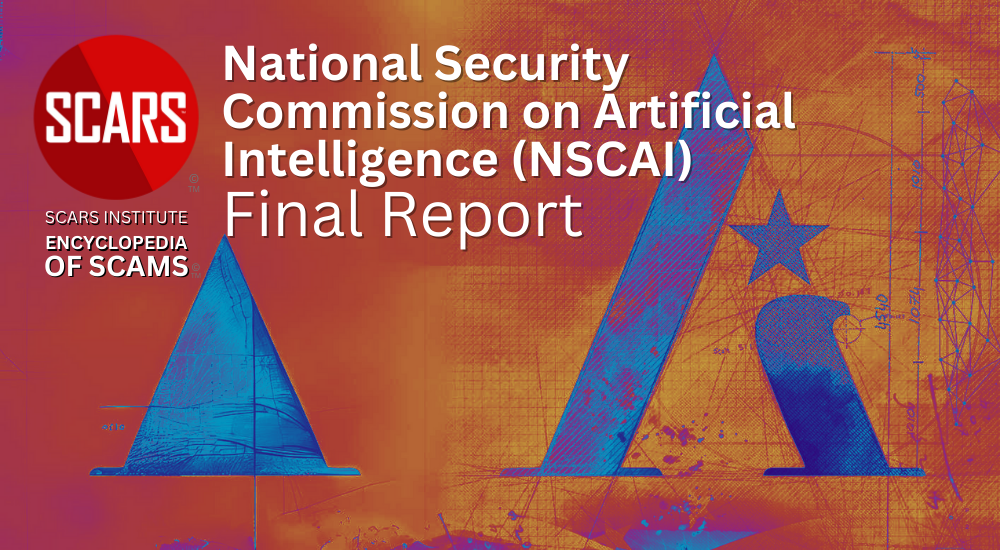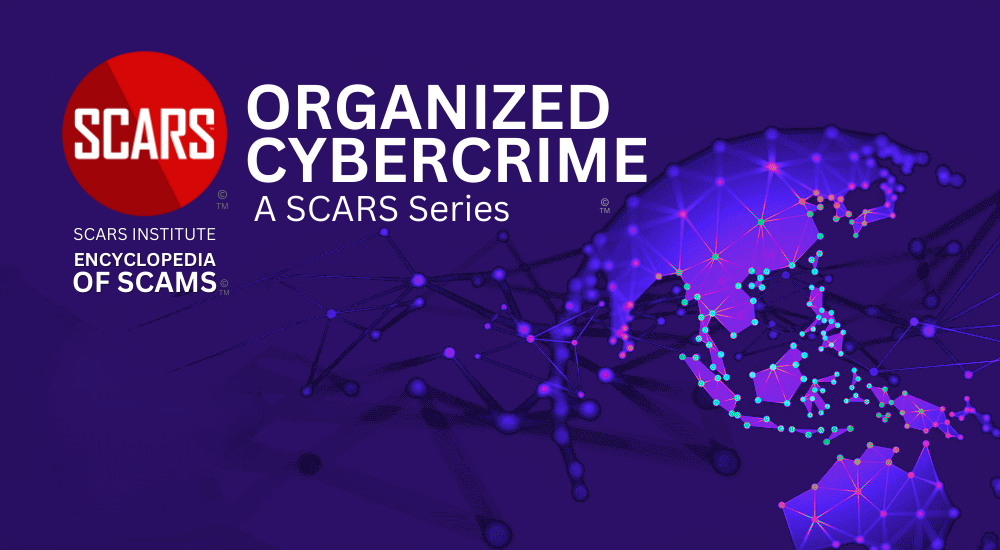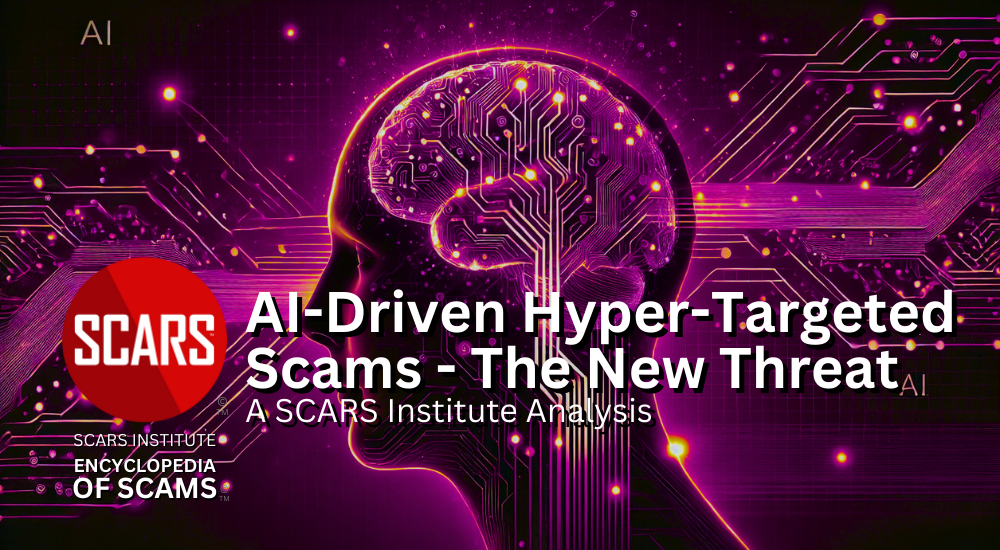
SCARS Institute’s Encyclopedia of Scams™ Published Continuously for 25 Years

AI-Driven Hyper-Targeted Scams – The New Threat
The Rise of AI-Driven Hyper-Targeted Scams: How ChatGPT and Other Models Are Revolutionizing Cybercrime for the Worse!
AI & Scams – A SCARS Institute Special Report
Author:
• Tim McGuinness, Ph.D., DFin, MCPO, MAnth – Anthropologist, Scientist, Director of the Society of Citizens Against Relationship Scams Inc.
Article Abstract
AI-driven scams are rapidly becoming more precise and manipulative, exploiting human vulnerabilities like never before. Tools like ChatGPT enable cybercriminals to engage in hyper-targeted scams, responding in real-time to victims’ behavior, and tailoring their manipulation strategies based on emotional and psychological cues.
These AI models can simulate intimate, convincing conversations, making scams like romance fraud and crypto-investment schemes even harder to detect. By analyzing language patterns, AI can assess a victim’s financial capacity, detect hesitation or resistance, and adjust its approach to maximize financial exploitation. Additionally, AI can act as a form of lie detector, evaluating emotional cues and increasing pressure when needed to push victims further into compliance.
The risk is compounded by AI’s ability to scrape personal data from social media and public databases to craft more personalized and convincing scams. To protect individuals, society must develop AI-driven countermeasures and promote vigilance, as the financial and emotional toll of these scams is only expected to grow.

The Rise of AI-Driven Hyper-Targeted Scams: How ChatGPT and Other Models Are Revolutionizing Cybercrime for the Worse!
Artificial intelligence (AI) has rapidly evolved in recent years, offering groundbreaking tools like ChatGPT and other advanced language models that have significantly impacted numerous industries.
While many focus on AI’s positive uses—automating tasks, enhancing productivity, and assisting in research—a darker side of this technology is emerging. Cybercriminals are beginning to harness the power of AI to engage in hyper-targeted scams that exploit victims on a deeply personal level. These AI-driven schemes can analyze a victim’s responses, tailor conversations to maximize emotional manipulation, and ultimately harvest every penny from unsuspecting targets.
This article will explore how scammers might use AI models like ChatGPT to execute sophisticated and devastating scams, delving into the mechanics of these operations and the potential consequences for victims.
The Evolution of Scams: From General to Hyper-Targeted
In the past, scammers often relied on generic, mass-produced messages and templates—such as poorly worded phishing emails, “Nigerian prince” scams, or basic impersonation schemes—to lure in victims. While some of these techniques still work, many people have become more aware of these schemes, causing scammers to innovate. Today, scammers aim for more sophisticated approaches, and AI tools like ChatGPT can now enable hyper-targeted, specific, and highly personalized grooming, manipulation, and control.
AI can analyze vast amounts of data, learn from interactions, and use natural language processing to create personalized and persuasive messages that are difficult to distinguish from genuine human communication and they can do it instantaneously. This allows scammers to adapt their tactics based on each victim’s unique responses, interests, and vulnerabilities, making the manipulation process far more effective and harder to detect.
How Scammers Use AI and ChatGPT for Targeted Scams
Scammers are now exploring how AI models, like ChatGPT, can be used to deceive, manipulate, and control victims in ways that were previously impossible. These models are highly capable of processing language and generating human-like responses, making them ideal tools for crafting scams that are hyper-targeted and responsive to a victim’s emotional state.
Personalized Engagement and Emotional Manipulation
ChatGPT and similar models can simulate meaningful conversations that seem thoughtful and well-informed. Scammers can use these AI-driven conversations to create an emotional bond with the victim, particularly in romance scams, fake job offers, or even fraudulent customer service interactions. Unlike traditional scripted scams, these AI-powered conversations can adapt in real-time based on the victim’s responses.
For example, a scammer using AI could:
-
-
- Engage in ongoing dialogue with a romance scam victim, responding in a natural, emotionally intelligent way to keep the victim emotionally invested.
- Tailor responses to match the victim’s interests, background, or emotional state. For instance, if the victim mentions feeling lonely or financially insecure, the AI can adapt the scam narrative to provide comfort or offer “solutions” that would deepen the scam.
- Analyze the victim’s psychological state based on their responses and manipulate them with precision. For example, if a victim expresses fear or anxiety about losing money, the AI might reassure them or offer “guarantees” to lower their guard.
-
Hyper-Targeted Phishing and Business Email Compromise
AI models like ChatGPT can also be used to refine phishing attacks and business email compromise (BEC) scams. Traditional phishing emails are often poorly written or generic, which makes them easier to spot. However, an AI-driven phishing attack can create highly convincing emails tailored to the victim’s specific role, organization, or personal interests.
Here’s how it works:
-
-
- Data mining and contextual analysis: AI can analyze publicly available information (e.g., social media profiles, LinkedIn data, and corporate websites) to gather information about a target. This data can then be used to craft a phishing email that appears highly personalized. For instance, if a person posts about attending a conference, the scammer could send an email pretending to be from an event organizer asking for payment or sensitive information.
- Adaptable email dialogue: Once a victim responds to a phishing email, the AI can adapt the conversation to fit the situation. For instance, if the victim expresses doubt or asks clarifying questions, the AI can respond intelligently, building trust and lowering the victim’s defenses.
- Impersonating real contacts: In a business email compromise scam, the AI can imitate the writing style of the victim’s colleagues, clients, or business partners. By analyzing previous communication patterns, the AI can produce messages that sound like they come from trusted sources, making it easier to convince victims to transfer funds or disclose confidential information.
-
Social Engineering Through Personalized Scenarios
Scammers have long used social engineering tactics, exploiting human psychology to manipulate victims. With AI tools like ChatGPT, these tactics can now be personalized in unprecedented ways. Instead of using generic scripts, scammers can create detailed, believable scenarios tailored to each victim’s specific circumstances.
For example:
-
-
- Impersonation of professionals: AI can simulate conversations with “professionals” such as lawyers, financial advisors, or tech support. These AI-generated interactions can be highly convincing, using the victim’s personal data to build a credible backstory. For instance, if a scammer has access to some of the victim’s financial information, they can use AI to craft a scenario where they are offering “investment advice” or “financial help.”
- Creating urgency or fear: By analyzing the victim’s emotional responses, the AI can determine which tactics are most effective—whether it’s creating a sense of urgency, fear, or offering comfort. This dynamic approach allows scammers to fine-tune their manipulative tactics to extract the most from each interaction.
- Tailored responses to objections: When a victim hesitates or shows signs of doubt, the AI can generate reassuring or logical responses to overcome the objection. For instance, if a victim questions why a payment is necessary, the AI could generate a plausible explanation that matches the specific scenario, making the scam harder to detect.
-
AI-Driven Deepfakes and Voice Emulation
In addition to ChatGPT’s text-based manipulation capabilities, scammers can use AI to create hyper-realistic deepfakes or voice emulation to support their scams. Video calls with what appears to be the victim’s “lover,” “business partner,” or “relative” could be orchestrated using deepfake technology, further cementing trust and credibility in the scam.
For example:
-
-
- Deepfake video calls: In a romance scam, the victim could be convinced they are video chatting with their online lover when, in reality, the AI-generated deepfake is manipulating them. This adds an additional layer of authenticity that is hard to refute, even if the victim had suspicions initially.
- Voice cloning: Using voice emulation AI, scammers could make phone calls to their victims, impersonating a known contact, such as a boss or family member. The combination of familiar voices and personalized, AI-driven dialogue increases the scam’s credibility.
-
Maximizing Financial Exploitation
One of the most alarming aspects of AI-driven scams is the potential for maximizing financial exploitation. Scammers can leverage AI to continually assess the victim’s emotional and financial state throughout the scam. By adapting their approach based on real-time feedback, the AI can strategically escalate requests for money or personal information at a pace that feels natural to the victim.
For instance:
-
-
- Building trust gradually: The AI might start with small, innocuous requests, like asking for small payments or favors. Once the victim is emotionally and financially committed, the AI gradually increases the stakes, asking for larger sums of money or sensitive information like credit card numbers.
- Exploiting moments of vulnerability: If the AI detects moments of heightened vulnerability—such as a death in the family or job loss—it can intensify its manipulation efforts, taking advantage of the victim’s weakened emotional state.
-
The Financial and Emotional Toll on Victims
The financial impact of AI-driven scams can be devastating, as AI allows for a level of precision and persistence in manipulation that was previously impossible. Victims may find themselves losing tens of thousands or even millions of dollars, often without realizing they’ve been targeted until it’s too late.
Emotionally, AI-driven scams can be even more damaging. Victims develop a deep emotional connection to their scammer, believing they are interacting with real, trustworthy individuals. When the truth is revealed, the emotional fallout can be catastrophic, leaving victims feeling violated, ashamed, and emotionally shattered.
The Next Frontier in Cybercrime
AI-Driven Hyper-Targeted Scams and the Dark Side of Tailored Psychological Manipulation
As artificial intelligence (AI) continues to evolve, so too does its potential to be weaponized by cybercriminals in ways that were once unimaginable. Today, AI-driven scams are not only more precise but also far more manipulative than traditional forms of cybercrime. Criminals can use AI models such as ChatGPT and similar systems to create hyper-targeted scams that adapt in real time, manipulating victims through psychological techniques designed to maximize exploitation. This marks a significant shift in cybercrime, where scammers can respond instantly to victim behavior, assess financial capabilities, and even detect resistance or deception—all in an effort to squeeze every last penny from their targets.
AI is transforming scams such as romance fraud and crypto-investment (pig butchering) scams by deploying tailored psychological manipulation, real-time assessments, and advanced profiling techniques. Additionally, AI can be used as a lie detector and financial assessment tool, giving scammers unprecedented control over their victims.
Tailored Psychological Manipulation: Instantaneous Responses to Engineer Control
AI models like ChatGPT enable scammers to interact with their victims in ways that feel deeply personal and responsive. Unlike the days of generic email scams, where a scammer would manually control a conversation, AI allows for instant, dynamic responses that feel uniquely tailored to each victim. These responses are designed to exploit psychological vulnerabilities, with AI analyzing the emotional state of the victim in real-time and adjusting its messaging to manipulate them further.
For example, in romance scams, AI can simulate intimate, compassionate conversations that deepen an emotional connection with the victim. As the victim shares more personal details, the AI can adjust its dialogue to mirror the victim’s values, beliefs, and emotional needs. By responding with comforting messages during times of emotional distress, the AI strengthens the victim’s attachment to the scammer, making it easier to manipulate them into sending money or sharing sensitive information. AI can instantly detect moments of doubt or hesitation and respond with reassurances, plausible excuses, or even affectionate language to maintain the victim’s trust.
Similarly, in crypto-investment scams (commonly known as pig butchering scams), AI can adapt to the victim’s financial anxieties or uncertainties. If a victim expresses skepticism about the legitimacy of a crypto-investment opportunity, AI can instantly provide seemingly knowledgeable answers or fake testimonials from “other investors,” complete with fabricated data on financial returns. These tactics not only reduce suspicion but also increase the likelihood of the victim continuing to invest more money.
AI as a Real-Time Lie Detector and Psychological Analyzer
One of the most dangerous features of AI in the hands of cybercriminals is its ability to act as a form of lie detector or psychological analyzer. By analyzing the language, tone, and patterns in a victim’s responses, AI can make assessments about whether the victim is being completely truthful or if they are holding back. This capability allows scammers to identify when a victim is showing resistance or suspicion and modify their strategy in real time.
For instance:
-
-
- Detecting hesitation: If a victim shows signs of reluctance to send money or provide personal information, the AI can quickly adapt its messaging to either guilt-trip the victim (“I thought you trusted me”), offer reassurance (“This is perfectly safe, I promise”), or escalate urgency (“If you don’t act now, you’ll miss this opportunity”).
- Reading emotional cues: AI can analyze sentence structure, word choice, and emotional tone to determine the victim’s emotional state. If a victim appears stressed or conflicted, the AI can employ comforting language or present alternative solutions that seem less risky but still lead to the same outcome—financial exploitation.
- Lie detection: By comparing the victim’s responses to previous messages or known patterns of deception, AI can infer whether the victim is being truthful about their financial situation or ability to send money. For example, if a victim claims they cannot afford to send more money, AI can subtly probe for inconsistencies or use guilt tactics to elicit more truthful answers.
-
This advanced level of psychological manipulation allows scammers to continuously escalate their tactics, ensuring that they extract the maximum possible financial gain from each victim.
Financial Profiling: AI-Assisted Assessments of Victim Wealth and Vulnerability
Scammers are not just using AI to manipulate conversations—they are also employing it to assess the financial profiles of their targets. With the vast amounts of data available through public records, social media, and even data services that sell consumer information, AI enables scammers to build highly detailed financial profiles of their victims before they even make contact.
AI can scrape social media profiles to identify key information about a victim’s lifestyle, career, assets, and spending habits. For instance, a scammer could use AI to determine:
-
-
- Employment history and job titles from LinkedIn profiles, giving them insights into the victim’s income level.
- Social media posts about vacations, luxury purchases, or hobbies, which can indicate disposable income.
- Family and relationships, which can be used to manipulate the victim by involving fake emergencies or exploiting their desire to help loved ones.
-
Beyond social media, scammers can use AI to access public databases containing property ownership records, court filings, or even corporate affiliations. They can further enhance this data by purchasing data services that provide access to credit scores, financial histories, and other sensitive information. With this comprehensive financial picture, scammers can tailor their scams to match the victim’s financial capacity. For example, a scammer targeting a wealthier individual may escalate the financial demands, asking for larger sums of money over a prolonged period, while targeting less affluent victims with more modest but frequent requests.
This financial profiling allows scammers to optimize their exploitation efforts, ensuring they are not leaving any money on the table. They know exactly how much a victim can afford to lose, and they can pace their scam accordingly.
AI’s Role in Pig Butchering Scams: A Perfect Fit for Crypto Fraud
AI-driven scams have found a natural ally in pig butchering scams, which target individuals by building a false sense of trust and investment success. In these scams, criminals convince victims to invest in what appears to be a lucrative cryptocurrency opportunity, only to gradually drain the victim’s funds after fattening them up with fake gains (hence the term “pig butchering”).
AI amplifies the effectiveness of these scams by:
-
-
- Simulating market success: Scammers can use AI to create fake trading platforms or generate fraudulent data showing that the victim’s investments are growing. The AI can generate real-time updates, congratulatory messages, and fake profits that entice the victim to invest more.
- Adapting to victim concerns: If the victim shows hesitation or confusion about the cryptocurrency market, AI can provide sophisticated explanations or tutorials, easing their concerns and building their trust. The AI can also detect when a victim is growing suspicious of the scheme and respond by offering fake withdrawal options, further luring the victim deeper into the scam.
- Escalating requests: As the victim’s trust grows, AI can gradually increase the financial demands, urging the victim to invest more by citing made-up market conditions or fake investment opportunities that appear to be time-sensitive.
-
The Unprecedented Threat to Victims and the Need for Vigilance
AI-driven hyper-targeted scams represent a significant leap in cybercrime capabilities, and the impact on victims is profound. Scammers now have tools that enable them to:
-
-
- Manipulate victims more effectively by analyzing their emotional and psychological states.
- Adapt scams in real time to overcome resistance and maximize financial gain.
- Profile victims with remarkable accuracy, ensuring that each scam is tailored to the individual’s financial situation and vulnerabilities.
-
For victims, the combination of these tactics means that scams are harder to detect and far more devastating. Victims may not realize they are being manipulated until it is too late, as AI-driven conversations feel real and persuasive, with responses that mirror their own thoughts, desires, and fears.
As scammers become more sophisticated, individuals must become more vigilant. Recognizing the signs of AI-driven scams—such as overly personalized messages, unusually fast and thoughtful responses, or requests for personal or financial information—will be crucial in protecting oneself from exploitation. Governments, corporations, and cybersecurity experts must also invest in countermeasures to detect and prevent these advanced scams before they cause widespread financial and emotional harm.
AI models like ChatGPT can potentially be used to analyze responses from scam victims in messages or emails and detect signs of psychological distress, cognitive distortions, and hyperactivation of the amygdala, though this application would require careful ethical considerations. While ChatGPT cannot directly detect biological changes like the activation of the amygdala, which is a brain region involved in emotional responses, it can infer emotional states from language patterns, choice of words, and sentence structures, which may suggest heightened emotional arousal.
How AI LLMs Like ChatGPT Could Analyze Victims’ Responses
According to ChatGPT itself:
AI models like ChatGPT can analyze language patterns in messages or emails to detect cognitive distortions and signs of emotional distress, potentially revealing when scam victims are experiencing psychological manipulation. By identifying fear-based language, emotional cues, and cognitive dissonance, AI can act as a tool to assess whether a victim is under heightened emotional pressure, indirectly suggesting hyperactivation of the amygdala. While this technology could help protect victims by recognizing when they are being manipulated, there is also a significant ethical concern—if scammers use AI to enhance their tactics, they could manipulate victims more effectively by detecting resistance and tailoring their responses accordingly. Thus, the use of AI in this context must be carefully regulated to ensure it is employed for victim protection rather than exploitation.
Cognition Detection
Identifying Cognitive Distortions
Cognitive distortions are irrational thought patterns that often emerge under stress or in emotionally charged situations. Some common distortions include:
-
-
-
-
- Catastrophizing (expecting the worst possible outcome)
- Overgeneralization (assuming one negative event represents a pattern)
- Black-and-white thinking (seeing situations as either all good or all bad)
-
-
-
An AI model can be trained to recognize these distortions in language. For example, if a scam victim writes, “I always make bad decisions,” or “Everything is ruined now,” the AI might flag these as signs of cognitive distortions like overgeneralization and catastrophizing. This would indicate that the victim is experiencing elevated emotional distress, potentially influenced by the scammer’s manipulative tactics.
Detecting Emotional Language and Hyperactivation of the Amygdala
While the amygdala’s activation is a neurological process, its effects manifest in how people express themselves emotionally. Individuals experiencing fear, stress, or anxiety may use more emotionally charged or urgent language. ChatGPT could detect:
-
-
-
-
- Fear-based language: Phrases like “I’m scared,” “What if…,” or “I’m afraid to lose everything” could signal amygdala hyperactivation.
- Increased urgency: Expressions of anxiety or pressure, such as “I need to do this now,” might indicate the person is experiencing intense emotional arousal, often driven by stress responses initiated by the amygdala.
- Repetitive emotional cues: Frequent use of words like “terrified,” “nervous,” or “anxious” might show that the victim is in a state of emotional hyperarousal.
-
-
-
Sentiment and Emotion Detection
AI models can analyze the overall sentiment (positive, negative, neutral) and emotion in written responses. Sentiment analysis algorithms already exist and could be integrated with AI tools to detect signs of fear, anger, sadness, or other emotions in real-time, flagging cases where victims may be emotionally overwhelmed by a scam.
Language Suggesting Vulnerability or Emotional Manipulation
Scam victims often display psychological vulnerability that could be detected through AI analysis:
-
-
-
- Pleading language: Victims who have been manipulated into thinking they are in danger may write messages pleading for help, reassurance, or approval, such as “Please don’t leave me,” “I don’t know what to do without you,” or “I’ll do anything.”
- Expressions of dependency: Emotional dependency on the scammer is a key feature of romance scams. Phrases like “You’re the only one who understands me” or “I need you” suggest emotional manipulation and control.
- Signs of doubt or cognitive dissonance: When a victim starts questioning the scam but remains conflicted, they may use language reflecting cognitive dissonance, such as, “I know this sounds strange, but…” or “I want to believe you, but I’m not sure.” AI could flag these moments as key opportunities for intervention.
-
-
Predictive Analysis of Scam Vulnerability
AI models like ChatGPT could also analyze multiple emails or conversations to identify patterns in the victim’s communication. This could reveal a progressive emotional decline, shifts in language toward more negative or anxious sentiments, or increasing cognitive distortions, which would indicate that the scam is working to manipulate the victim’s state of mind.
Ethical Considerations
While AI’s potential to analyze and detect psychological distress and cognitive distortions in scam victims is promising, it raises important ethical concerns:
-
-
- Privacy: Analyzing private messages for emotional distress requires clear consent from the users. Any AI tool designed for such purposes must prioritize user privacy and data security.
- Manipulative Uses: If used by scammers themselves, AI could be weaponized to detect resistance or skepticism in victims, allowing criminals to fine-tune their manipulative tactics. This poses a real threat, as AI could be used not just to deceive but also to anticipate and counter a victim’s doubts, making scams more effective.
- Intervention and Support: Ideally, AI would be deployed in a protective capacity, helping organizations or law enforcement detect when someone is being scammed and alert them in real time. This would require strong ethical guidelines and the involvement of mental health professionals to support victims during these vulnerable moments.
-
The Amygdala will Expose Victims to Increased Control
Detecting emotional language and signs of hyperactivation of the amygdala involves identifying patterns in communication that reflect heightened fear, anxiety, stress, or emotional arousal. Here are more examples that AI could potentially detect in scam victims:
Fear and Anxiety-Induced Language
When the amygdala is hyperactivated, fear responses are triggered, and this often manifests in urgent or panicked language. Some examples include:
-
-
- Expressions of fear and worry: “I’m really scared that this could go wrong,” or “What if I lose everything?”
- Repeated reassurance-seeking: “Are you sure this is safe?” or “I need to know that you’re not lying to me.”
- Hyper-awareness of consequences: “If I don’t do this right now, it could be the end of me,” or “I’m terrified of what could happen if I don’t act fast.”
- Catastrophizing language: “This is going to ruin me,” or “Everything is falling apart.”
-
These expressions often signal that the person is in a state of heightened emotional arousal, suggesting fear or anxiety, which scammers may induce to manipulate victims.
Urgency and Pressure-Based Language
When victims are experiencing emotional overload, often initiated by a scammer who creates a false sense of urgency, they may write in ways that reflect panic or immediate pressure:
-
-
- Time pressure statements: “I need to do this now or I’ll lose everything,” or “I only have a few hours to make this decision.”
- Fear of missing out (FOMO): “This is my only chance to get my money back,” or “If I don’t invest now, I’ll regret it forever.”
- Overcommitment due to pressure: “I have to make this work, no matter the cost,” or “I’ll do whatever it takes to make this happen.”
-
These types of messages suggest the person feels pressured into acting quickly, often as a result of manipulative tactics designed to induce panic, which are symptoms of emotional distress linked to amygdala hyperactivation.
Emotional Breakdown and Desperation
Victims who have been under sustained emotional pressure might exhibit signs of desperation, where their emotions override rational thinking. This can be seen in:
-
-
- Desperate pleas: “Please, I don’t know what to do anymore,” or “I’m begging you to help me.”
- Helplessness: “I feel completely powerless,” or “There’s nothing left I can do.”
- Expressions of overwhelming stress: “I can’t sleep or eat because of this,” or “My life is falling apart, and I can’t stop it.”
- Panic-driven actions: “I’m transferring the money right now, I hope it works,” or “I don’t care anymore, just tell me what to do.”
-
These phrases indicate a deep emotional investment and loss of control, often triggered by manipulation techniques that scammers use to maintain pressure on their victims.
Hypervigilance and Paranoia
When the amygdala is hyperactivated, it can lead to hypervigilance, where the victim becomes overly sensitive to threats or dangers, even when they are not present. Examples of this kind of language include:
-
-
- Paranoid thoughts: “I feel like someone’s always watching me,” or “I’m afraid everything is a trap.”
- Extreme caution: “I’m worried about every little detail,” or “I don’t trust anyone anymore, but I have to keep going.”
- Hyper-awareness of risk: “I feel like I can’t make a single mistake, or it will all be over,” or “Every step feels like it’s leading to disaster.”
-
These reactions reflect how the victim may be experiencing heightened anxiety and mistrust, which can make them more vulnerable to a scammer’s manipulations as they lose the ability to critically evaluate the situation.
Doubt and Cognitive Dissonance
When a victim’s emotional state becomes conflicted, often because they sense that something is wrong but cannot reconcile it with their attachment to the scammer, their language may reflect cognitive dissonance:
-
-
- Confusion and contradiction: “I don’t know what to believe anymore,” or “This doesn’t feel right, but I’m still not sure.”
- Rationalization: “I know it sounds crazy, but there must be a reason for this,” or “I’m just overthinking things, right?”
- Attempts to reconcile opposing ideas: “I trust them, but something keeps nagging at me,” or “I want to believe this is true, but I can’t shake the feeling that it’s not.”
-
These statements suggest the victim is struggling to align their emotions with the logical inconsistencies they are experiencing, indicating distress and inner conflict.
Submissive or Dependent Language
Scammers often manipulate victims into feeling dependent or submissive, where the victim becomes emotionally reliant on the scammer and expresses a need for validation or guidance:
-
-
- Expressions of need: “I can’t do this without you,” or “You’re the only one who understands me.”
- Seeking approval: “I’ll do whatever you think is best,” or “Is this what you want me to do?”
- Helplessness without the scammer: “I don’t know how I’d survive without your help,” or “I trust you to make this right for me.”
-
This language reflects deep emotional manipulation, often tied to feelings of vulnerability and fear, further deepening the control that the scammer has over the victim.
Detecting emotional language tied to hyperactivation of the amygdala involves identifying patterns of fear, urgency, doubt, and desperation. Victims under emotional manipulation in scams often use language that reflects psychological stress, feelings of helplessness, and confusion. AI models can analyze these cues in real-time, providing insights into the victim’s emotional state and potentially offering a window into moments where intervention could prevent further exploitation. However, this also highlights the potential for AI to be misused by criminals to deepen control over their victims by detecting and responding to these emotional cues more effectively.
Conclusion
AI is the Future of Scams, Fraud, and Cybercrime
As AI continues to advance, the sophistication and effectiveness of scams will only increase. ChatGPT and other AI models enable scammers to exploit human vulnerabilities in hyper-targeted, adaptive ways, making these scams harder to detect and more damaging than ever. The financial losses and emotional devastation resulting from AI-driven scams are likely to escalate as cybercriminals refine their techniques.
AI is transforming the landscape of cybercrime, allowing scammers to execute hyper-targeted, psychologically manipulative scams that are highly adaptive and precise. With tools like ChatGPT, scammers can instantaneously respond to victim behavior, analyze emotional and financial vulnerabilities, and optimize their tactics for maximum exploitation. As AI continues to evolve, so will the threats posed by these advanced scams. Combatting this new era of cybercrime will require greater awareness, enhanced cybersecurity measures, and the development of tools to detect and neutralize AI-driven fraud before it devastates more lives.
AI models like ChatGPT can analyze language patterns to detect cognitive distortions, emotional distress, and hyperactivation of the amygdala (indirectly through emotional language cues). While these capabilities could help protect victims by recognizing when they are under psychological manipulation, the technology also poses risks if used by scammers to further exploit their victims. The implementation of AI in combating scams must be handled with care, ensuring that its power is used to safeguard victims and not to enhance criminal activity.
For society to combat these emerging threats, a multifaceted approach is needed. This includes raising awareness, enhancing cybersecurity measures, and developing AI-powered tools to detect and prevent these sophisticated scams. Only by staying ahead of AI-enabled fraudsters can we hope to protect individuals from the devastating consequences of these highly targeted attacks.
A Note About Labeling!
We often use the term ‘scam victim’ in our articles, but this is a convenience to help those searching for information in search engines like Google. It is just a convenience and has no deeper meaning. If you have come through such an experience, YOU are a Survivor! It was not your fault. You are not alone! Axios!
Statement About Victim Blaming
Some of our articles discuss various aspects of victims. This is both about better understanding victims (the science of victimology) and their behaviors and psychology. This helps us to educate victims/survivors about why these crimes happened and to not blame themselves, better develop recovery programs, and to help victims avoid scams in the future. At times this may sound like blaming the victim, but it does not blame scam victims, we are simply explaining the hows and whys of the experience victims have.
These articles, about the Psychology of Scams or Victim Psychology – meaning that all humans have psychological or cognitive characteristics in common that can either be exploited or work against us – help us all to understand the unique challenges victims face before, during, and after scams, fraud, or cybercrimes. These sometimes talk about some of the vulnerabilities the scammers exploit. Victims rarely have control of them or are even aware of them, until something like a scam happens and then they can learn how their mind works and how to overcome these mechanisms.
Articles like these help victims and others understand these processes and how to help prevent them from being exploited again or to help them recover more easily by understanding their post-scam behaviors. Learn more about the Psychology of Scams at www.ScamPsychology.org
-/ 30 /-
What do you think about this?
Please share your thoughts in a comment below!
Table of Contents
LEAVE A COMMENT?
Recent Comments
On Other Articles
- Arwyn Lautenschlager on Scam Victim Grooming – Turning On The Instant Emotions: “I can relate to the explanations of the various ways a scammer grooms/manipulate their victim. There were times when I…” Jan 6, 13:56
- on An Updated Compendium Of Confidence Tricks: “In my first scam, I received a $150,000 check address to my scammer from a company in California, but the…” Jan 4, 22:46
- on Romance Scammers – Top Lies They Tell – UPDATED 2024: “Thank you for the valuable information and telling us we just have to report it to the FTC, because the…” Jan 4, 19:12
- on Love Bombing And How Romance Scam Victims Are Forced To Feel: “I was loved bombed and sent flowers, he even asked me to find houses we could live in my town.…” Jan 4, 09:55
- on Scam Grooming: Finding Common Interests: “I was divorced and lost my mom in the same month, I had moved to my hometown and had very…” Jan 4, 09:18
- on Scammers Start By Grooming Scam Victims – Spotting An Online Scam Groomer – Grooming As A Scam Technique – 2024: “As I read this article, I could envision my former self (as if in a movie watching myself) in my…” Jan 3, 13:21
- on The Meaning Behind Scammer Gifts Sent To Romance Scam Victims – 2024: “They were probably purchased using stolen credit cards anyway.” Jan 3, 13:18
- on The Meaning Behind Scammer Gifts Sent To Romance Scam Victims – 2024: “I got flowers from my criminal, he had me take a picture with the flowers. He later gave me several…” Jan 3, 11:23
- on 7 Deadly Sins of Post Scam Victim Vulnerability – 2023 UPDATED 2026: “Thank you for a great article. I will continue to learn, through learning I can gain wisdom, use the steps…” Jan 3, 11:00
ARTICLE META
Important Information for New Scam Victims
- Please visit www.ScamVictimsSupport.org – a SCARS Website for New Scam Victims & Sextortion Victims
- Enroll in FREE SCARS Scam Survivor’s School now at www.SCARSeducation.org
- Please visit www.ScamPsychology.org – to more fully understand the psychological concepts involved in scams and scam victim recovery
If you are looking for local trauma counselors please visit counseling.AgainstScams.org or join SCARS for our counseling/therapy benefit: membership.AgainstScams.org
If you need to speak with someone now, you can dial 988 or find phone numbers for crisis hotlines all around the world here: www.opencounseling.com/suicide-hotlines
A Note About Labeling!
We often use the term ‘scam victim’ in our articles, but this is a convenience to help those searching for information in search engines like Google. It is just a convenience and has no deeper meaning. If you have come through such an experience, YOU are a Survivor! It was not your fault. You are not alone! Axios!
A Question of Trust
At the SCARS Institute, we invite you to do your own research on the topics we speak about and publish, Our team investigates the subject being discussed, especially when it comes to understanding the scam victims-survivors experience. You can do Google searches but in many cases, you will have to wade through scientific papers and studies. However, remember that biases and perspectives matter and influence the outcome. Regardless, we encourage you to explore these topics as thoroughly as you can for your own awareness.
Statement About Victim Blaming
Some of our articles discuss various aspects of victims. This is both about better understanding victims (the science of victimology) and their behaviors and psychology. This helps us to educate victims/survivors about why these crimes happened and to not blame themselves, better develop recovery programs, and to help victims avoid scams in the future. At times this may sound like blaming the victim, but it does not blame scam victims, we are simply explaining the hows and whys of the experience victims have.
These articles, about the Psychology of Scams or Victim Psychology – meaning that all humans have psychological or cognitive characteristics in common that can either be exploited or work against us – help us all to understand the unique challenges victims face before, during, and after scams, fraud, or cybercrimes. These sometimes talk about some of the vulnerabilities the scammers exploit. Victims rarely have control of them or are even aware of them, until something like a scam happens and then they can learn how their mind works and how to overcome these mechanisms.
Articles like these help victims and others understand these processes and how to help prevent them from being exploited again or to help them recover more easily by understanding their post-scam behaviors. Learn more about the Psychology of Scams at www.ScamPsychology.org
Psychology Disclaimer:
All articles about psychology and the human brain on this website are for information & education only
The information provided in this article is intended for educational and self-help purposes only and should not be construed as a substitute for professional therapy or counseling.
While any self-help techniques outlined herein may be beneficial for scam victims seeking to recover from their experience and move towards recovery, it is important to consult with a qualified mental health professional before initiating any course of action. Each individual’s experience and needs are unique, and what works for one person may not be suitable for another.
Additionally, any approach may not be appropriate for individuals with certain pre-existing mental health conditions or trauma histories. It is advisable to seek guidance from a licensed therapist or counselor who can provide personalized support, guidance, and treatment tailored to your specific needs.
If you are experiencing significant distress or emotional difficulties related to a scam or other traumatic event, please consult your doctor or mental health provider for appropriate care and support.
Also read our SCARS Institute Statement about Professional Care for Scam Victims – click here to go to our ScamsNOW.com website.
















Thank you for your comment. You may receive an email to follow up. We never share your data with marketers.